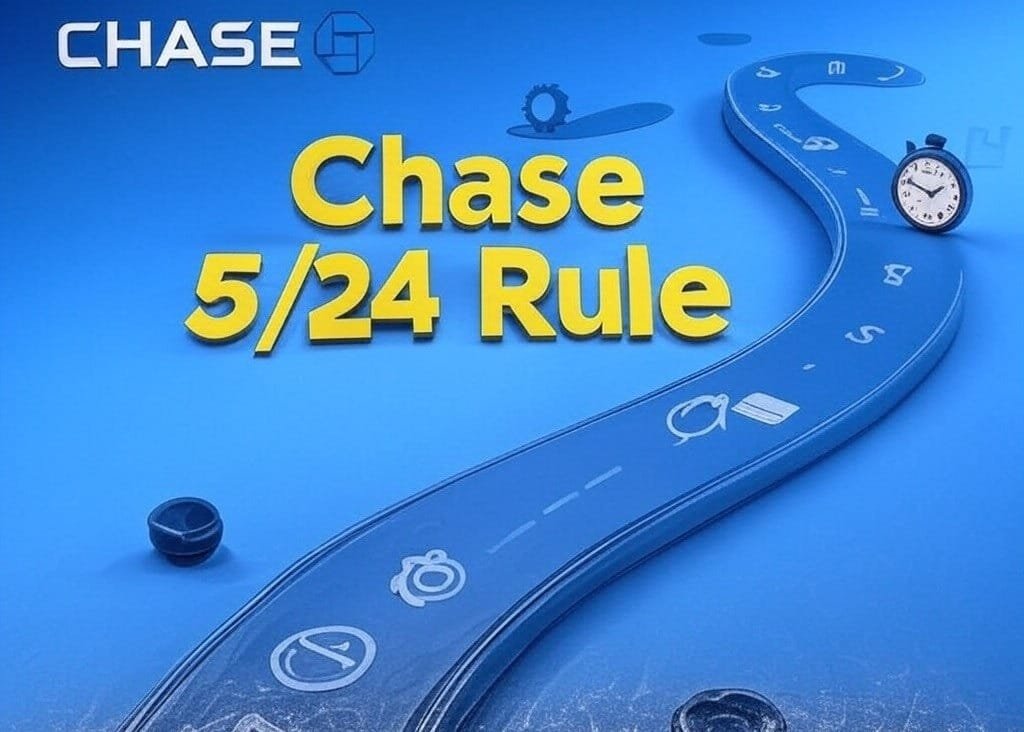Affiliate Disclosure: Travel with Plastic may earn a commission or referral bonus from some links on this site. These affiliate links help support our work and may influence the placement or promotion of certain products or services. However, our content is independently crafted to reflect honest opinions. Not all offers or products are included. There is no additional cost to users when they utilize our affiliate links.
The Chase 5/24 rule can block you from getting their best credit cards. This policy is crucial for your credit card application strategy. It’s important to understand its impact on your plans.
Chase’s 5/24 rule limits new credit card approvals. It applies if you’ve opened five or more personal cards in 24 months. This policy affects how people manage their credit card portfolios.
Credit card fans must grasp this policy’s details. If you’ve been applying for cards often, you might not qualify for Chase’s offers. Knowing the 5/24 rule helps you time your applications better.
The 5/24 rule aims to prevent credit card churning. It protects Chase’s interests by ensuring only stable credit profiles access premium cards.
Navigating this rule requires careful planning. A strategic approach to applications is key. Understanding the details helps maximize rewards while following Chase’s guidelines.
Understanding the Chase 5/24 Rule
The Chase 5/24 rule is key for credit card enthusiasts. It affects how people apply for Chase cards. This unwritten policy shapes credit strategies.

The rule’s core principle is simple. Chase often rejects applications if you’ve opened five or more personal cards recently. This applies to cards from any issuer in the past 24 months.
Definition and Basic Principles
The Chase 5/24 rule has some key points:
- Applies to most Chase personal credit cards
- Counts cards from all credit card issuers, not just Chase
- Includes store credit cards and personal credit cards
History and Evolution of the Rule
Chase introduced this policy around 2016. They never officially published the details. The rule aims to manage credit risk and protect their card portfolio.
Why Chase Implemented This Policy
Chase created this rule to:
- Reduce credit risk
- Target more selective, loyal customers
- Protect against potential credit card churning
To navigate the Chase 5/24 rule, track your credit card applications carefully. Smart consumers monitor their card openings to stay within Chase’s guidelines.
How to Calculate Your 5/24 Status
The Chase 5/24 rule affects your credit card approval chances. Understanding how to calculate your status is crucial. This method helps determine if Chase will approve your new card application.
Here’s how to calculate your 5/24 status:
- Review all personal credit cards opened in the last 24 months
- Count only personal credit card accounts
- Include both open and closed accounts from the past 24 months
- Verify the exact opening dates of each card
Remember these key points for your credit card strategy:
- Authorized user cards count towards your 5/24 status
- Business cards (with some exceptions) do not count
- Loans like mortgages and auto loans are not included
Even closed accounts from the past 24 months affect your 5/24 status. If you’ve opened three personal cards from different issuers, your status would be 3/24.
Use free credit reporting tools like Experian or AnnualCreditReport.com to track your accounts. A detailed spreadsheet can help manage your credit card applications strategically.
Credit Cards Affected by Chase 5/24 Rule
The Chase 5/24 rule impacts many credit card approvals. It covers personal, business, and co-branded cards. Understanding this rule is key for successful applications.
The 5/24 rule creates hurdles for credit card approval. Applicants must track their recent card openings carefully. This helps maximize their chances of getting a Chase card.
Personal Credit Card Lineup
Chase’s personal credit cards are subject to the 5/24 rule. Popular options include:
- Chase Sapphire Preferred
- Chase Sapphire Reserve
- Chase Freedom Unlimited
- Chase Freedom Flex
Business Credit Card Considerations
Business credit cards offer unique strategies for the 5/24 rule. Some options are:
- Ink Business Preferred Credit Card
- Ink Business Cash Credit Card
- Ink Business Unlimited Credit Card
- World of Hyatt Business Card
Co-Branded Card Restrictions
Co-branded cards with partners like United, Southwest, and Marriott follow the 5/24 rule. Applicants should review their recent credit card history before applying. This helps ensure they meet Chase’s requirements.
Pro Tip: Track all credit card openings across different banks. This helps you stay within Chase’s 5/24 limit.
Accounts That Don’t Count Toward 5/24
The Chase 5/24 rule has exceptions. Some credit card applications don’t affect your 5/24 status. This gives you more options when applying for cards.
Certain accounts are exempt from the 5/24 rule. These include mortgages, installment loans, auto loans, and student loans. Rejected credit card applications also don’t count.
Most business credit cards from major banks are excluded too. This means you can open these without impacting your Chase eligibility.
- Mortgages and installment loans
- Auto loans and student loans
- Credit card applications that were not approved
- Most business credit cards from specific banks
Business cards from American Express, Bank of America, Chase, and others don’t affect 5/24. This allows you to open new accounts while preserving Chase eligibility.
However, TD Bank and Discover business cards do count against 5/24. Capital One’s business cards are tricky. Some may impact your 5/24 count.
Knowing these details helps you plan your credit card strategy. It can boost your chances of getting approved for Chase cards.
Strategies to Navigate the 5/24 Rule
The Chase 5/24 rule requires smart planning and careful credit card management. Savvy cardholders can create a strategy to maximize sign-up bonuses. This approach helps stay within Chase’s restrictions.
Effective ways to handle the Chase 5/24 rule involve a nuanced approach. Credit fans can use several key strategies to their advantage.
- Time your applications carefully to minimize impact on 5/24 status
- Prioritize high-value Chase cards with significant rewards
- Explore targeted “Just for You” offer opportunities
Timing Your Applications
Spacing out credit card applications is vital. Experts suggest waiting 90 days between applications. This helps reduce the risk of hitting the 5/24 limit.
Keep track of your current status carefully. Note when each card was opened to stay on top of things.
Priority Card Selection
Select cards strategically by focusing on:
- Chase cards with highest sign-up bonuses
- Cards that align with your spending patterns
- Potential long-term value beyond initial rewards
“Just for You” Offer Opportunities
Some cardholders can bypass 5/24 restrictions through targeted “Just for You” offers. Check these special promotions in your Chase account.
Look under “Explore products” in the left-hand menu. These strategies can help maximize rewards within Chase’s guidelines.
Conclusion
The Chase 5/24 rule is vital for credit card churning. It requires careful planning and understanding of how new cards affect your credit profile. This rule demands strategic card selection to maximize rewards while avoiding potential issues.
Credit card approval strategies have become more complex. The 5/24 rule is more than a simple restriction. It’s a comprehensive approach to managing credit card applications. Chase limits approvals to five personal cards within 24 months across all banks.
Success comes from thoughtful planning and patience. Space out your applications and choose cards with valuable sign-up bonuses. Maintain a long-term perspective when navigating Chase’s approval process. The 5/24 rule encourages strategic and responsible credit card management.
Credit card enthusiasts must stay adaptable. Banking policies and credit card rewards are always changing. Stay informed about rules like the 5/24 limit. Approach credit applications with a calculated strategy to maximize rewards and maintain good credit.

